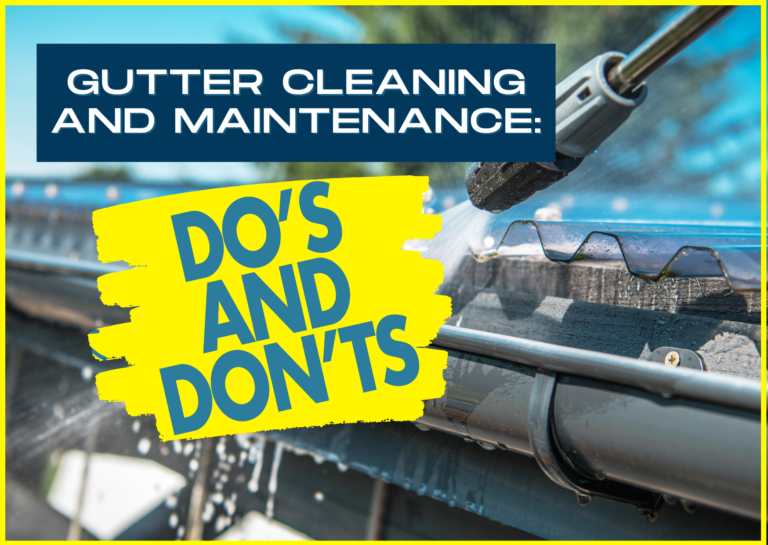When you upgrade or build a house, you’ll need to make numerous decisions! The design, the aesthetics, the layout—all the options can be overwhelming for a homeowner. Of the many major things to consider when building a home, one thing that should not be left out is the types of rain gutters you should install.
Most of the time, gutters are something that most homeowners don’t give much thought to. If you spend so much time scouting for the best home building products and services because you want to get maximum care and amazing artistic value, why single out your guttering? In this article, let’s highlight all the things you need to know about rain gutters to narrow down your options and make a suitable decision.
What are rain gutters?
Rain gutters are used to keep your property away from the dangers of water and rain damage. These gutters consist of trough-like channels that are secured beneath the slopes of the roof. They are made either of vinyl, aluminum, cast iron, and other materials. The purpose of rain gutters is simple: it simply catches the rainwater and redirects them away from your home’s foundation.
Collecting and redirecting rainwater is very simple: once there is rain, the rainwater flows down the roof and cascades into the gutters’ different channels. These channels are installed at a slightly downward angle. The water rushes to the downspout opening, where it then takes the water down the ground. Once it’s hit at the floor level, water is stored into containers, splash blocks, or to a drainage system that further leads the rainwater away from your property.
Importance of Rain Gutters
A rain gutter’s function is very basic, but it can do so much both for home and commercial properties:
- The right rain gutter system can help keep your property’s foundation dry and safe because it keeps excess water away from “touching” them. When this happens, the foundation is susceptible to structural cracks. Water can also rot and eventually weaken wooden structural components. Thus, it’s crucial to keep rainwater away from your home. Thankfully, rain gutters can help achieve that. It is designed to take rainwater from the roof down to a designated area that’s far enough from the most critical areas of your house.
- Rain gutters protect your home’s exterior walls from seepage. When there is excess rainwater, it can potentially dissolve the plaster protection of your exterior wall. This leaves you with a weakened wall, a bubbled paintwork, and other conditions prone to bacterial and fungal growth. When you have the right rain gutter system, this will help minimize the water amount that your home exterior is exposed to. This keeps your walls from getting water damages.
- Rain gutters are the eco-friendly solutions for your garden and lawn. How? Because the rainwater can be directed to an irrigation system or storage containers that you can later use to water your plants.
- Rain gutter systems add a touch of extra to your exterior decors. Not only are they functional, but they can also add more aesthetics to your property. Gutters can add that distinctive element to the total appearance of your structure. For instance, copper gutters are utilized in restoring historic buildings and properties that wish to achieve that antique and classic look.
- Installing the right rain gutter can also boost the value of your home in the market. Not only do gutters improve the look of your property’s exteriors, but they also make great security assets. Many property buyers, especially in strong and heavy rainy seasons, are very keen on checking a home’s gutter system. Meaning, the more maintained your gutter system is, the more valuable your property becomes.
- Gutters are cost-effective because they are relatively meager investments that can last for as long as 30 years or more, although this will greatly depend on the materials used and the maintenance you practice in keeping them in their top shape.
- Gutters can extend your property’s life span. Considering the costly problems that storms and rainfalls can cause your property, the most practical solution is to prevent this from happening. Installing the right gutter system ensures that your property will remain safe for years to come.
The 8 Types of Rain Gutters for Your Home
When looking for gutters, remember that you can access different types, colors, sizes, and prices that fit your need and budget. Are you planning to upgrade or install a new gutter for your house, but you’re at a loss about the type of gutter you will get?
Here are great tips:
Types of Gutter According to Shape
K-Style Gutters. These are the types of rain gutters mostly used nowadays. Also called an “ogee,” this gutter type is winning the hearts of many homeowners because of how it looks, plus the fact that this is very decorative. This gutter’s profile is curvier, and its overall appearance is somewhat similar to a crown molding. Because of its forms, K-style gutters are usually secured around ceilings, and they make perfect choices in areas with constant and heavy rains. What’s great about the K-style gutters is that not only do they come in different sizes and makes, but they can also be created on-site for that perfect fit. And since these gutters are seamless, they are expected not to leak easily.
Victorian Ogee. Also called Old Gothic, these types of home rain gutters are unique because of their aesthetic outline, making them perfect for many homes. This gothic style, using a cast-iron, was derived during the earlier years. While they look traditional, no one can deny how stylish these Victorian ogee rain gutters are. Even if it looks old, it still works well with traditional or period homes. The downside, though, is that these gutters are too shallow. It cannot handle too much water. Thus it’s best suited for smaller homes. But the good news is that Victorian Ogee gutters are customizable.
Fascia Gutters. These are the types of gutters installed in homes where no fascia board is installed. Fascia gutters work both as a fascia board and a gutter. They conceal the roof tails in a way that nobody can see anything just by plainly looking at your house. This results in a smoother line and cleaner look while also keeping away possible animal intrusions and water damages.
Half-Round Gutters. If you are looking for a gutter to boost your home’s overall look without being too loud at it, your best bet is the half-round type gutters. At first glance, these gutters look just like the traditional ones. However, they can even work on specific architectural designs. After these types of gutters are installed, you are to decide on the many styles available. Meaning, you can find reverse-beads, double-beads, and single-beads. But regardless of the style, the overall excellent performance that these types of gutters deliver will remain.
With these gutter types, you also have to select your preferred materials. It makes it even more fun because you get to choose the gutter style that you think will match and complement your home’s overall look. You can also have these gutters cut based on the length you need, plus you can go for concealed hangers to hide those unnecessary methods on how you attach them.
European Gutters. These are other gutter types with beads from the outside. European gutters are usually attached to houses with half-round hangers. These gutters are very attractive and can add elegance to a property. For this reason, European gutters are a common choice for many homeowners. What’s makes these gutters a very good investment is their distinctive and very shiny coating that can last for years.
European gutters work excellently in areas prone to heavy storms and temperature changes. The materials made in these gutters are generally strong and can stand even thru harsh weather conditions without the risk of getting damaged. They also have round and wide downpipes secured in the gutters, making them worry-free for clogging. Also, it’s been proven that animals cannot make their homes on these gutters
Types of Gutter According to Material
Aluminum Gutters. This is the most common gutter type and is widely used by many. Aluminum gutters are very lightweight and easy to install, and it cuts your worries about corrosion that can significantly affect its whole appearance. You can also match the gutter to any existing color of your other gutters. Gutter installers will not have a hard time installing these types of gutters because they can be made and cut at your house.
Copper Gutters. These are ideal for homeowners who worry too much about molds growing in their gutters or needing more repaint than usual. Copper gutters are very attractive over time, thus making your home look more elegant than ever. The downside, though, is that these gutters are not durable. Even a slight falling tree can cause too much damage. Because of its reduced lifespan, some homeowners are cautious about installing these types of gutters.
Galvanized Steel Gutters. These types of gutters are made of steel and protected with a zinc layer. Galvanized steel is known for its strength, but it can be damaged with rust. If you prefer to install these types of rain gutters for your home, be prepared for dents and scratches. It’s advisable to have these gutters installed by professionals because improperly securing them can potentially end up with little space for your whole drainage system. When this happens, standing water is possible near your home. It’s also good to clean these gutters regularly to check for clogs and rust.
Vinyl Gutters are also good options since they are made of strong plastic. They are very efficient against bending, corrosion, and dents, making them great choices if you live in a place prone to severe storms. With vinyl gutters, it’s not necessary to clean them every after raining. Additionally, vinyl is very lightweight, making them very easy to install. They also don’t need painting, thus lowering your worries about those unsightly marks.
Other Types of Rain Gutters
Types of Gutter According to Construction
Sectional Gutters. These gutters are made from combined pieces of different lengths. Upon combining, the pieces are secured and trimmed to the exact fit of your home. The lengths have connected either side by side or per corners. Although these gutters cannot be customizable, experts say these are still relatively easy to handle because they cut and install quickly. The most common drawback, however, leaks usually on the connection points of each section. This will lead the water to easily slide down on the sides of the wall, therefore increasing the risk of causing mold. You can mitigate these concerns, though, by regularly cleaning your sectional gutters.
Seamless Gutters. These are one-piece seamless gutters with connections found on the downspout and the corners. Meaning, they are strong and stable enough, minimizing the chance of any leaks even on hard storms. Seamless gutters are created to last to give homeowners that much needed peace of mind. To have these gutters fit perfect, it’s wise to seek an experienced roofer who can deal with custom made, seamless gutter installation. Additionally, special tools are needed to make, cut, and fix them. These gutters also come in a wide variety of color options.
Types of Gutter According to Sizes
5-inch Rain Gutters. Among the many gutters style, the most common sizes are the 5-inch gutters. This size is typically spacious enough for most homes sine this can already handle enough water. But if you stay in places where rain is common, it’s best to go for those with wider downspouts because this can help the gutters wash away the rainwater quickly.
6-inch Rain Gutters. The 6-inch rain gutters are common sizes for the half-round gutters. Assessing your house if these gutters are ideal or not can be tricky. If you’re not sure about it, talk to your local roofing expert. Discuss your place’s rainfall density, your roof’s terrain, or your drainage system, among others. By providing the expert with the necessary information, he can easily identify and assess what size will best fit your house. This gives you no room for worries about any possibilities of water damages.
Types of Gutter According to Color
Neutrals. Just like any other color for your household things, the safest choice is neutral colored gutters. These colors won’t clash with your home’s present look; neither do they contrast too much. Before choosing the color, consider first the colors in your garage and then think about how it can match your gutters. Remember that gutters are visible from a distance. Go for gray, tan, brown, or white for that perfect blend, sharp lines, and appealing outline.
Bolds. If you’re more on the adventurous side, be bold with your color choices. Go for colors that will stand out from other houses in your area. Whether it’s pink, Kelly green, bright blue, or even yellow, think of colors that you know will make your home unique. But still consider your exterior decoration, style, and outdoor landscape before you commit to installing bright and fun-colored gutters.
Rain gutters can be installed from scratch or placed on your existing rooftop for your re-roofing projects. Before you sign a deal with your contractor, don’t forget to consider the things mentioned above like coating, material, type, size, and even color.
Do You Need to Install Gutters Around Your Entire Property?
Over the years, rain gutters have quickly become a standard part of many homes. Gutters are there to keep all the rainwater away from your home’s foundation and overall structure. But do all houses need to have a rain gutter? What if you live in a tiny house in a dry climate? Is it still necessary to install a sophisticated rain gutter system?
Why do you need rain gutters?
As discussed above, rain gutters are designed to collect rainwater coming from your roof. They are made of durable materials that can withstand even the heaviest flow of water. Gutters are installed around the roof to guide the water away from your house and, at the same time, keep leaks and slow down the deterioration of the structure and foundation of your home.
Having a faulty rain gutter system eventually results in soil erosion, and when not immediately addressed, this can degrade the structure that they’re built around, especially when water starts to seep into the walls and floors. There are even cases where a single heavy rainstorm led to heavy flooding because there was no way of diverting the rainwater to a safe distance.
Although these are only exceptional cases, a building’s design sometimes makes rain gutters more of a hassle than a benefit. If the need calls for it, customize your gutters to fit your property’s structure without the need for changes on your home.
But do you need gutters around your whole house?
The answer generally depends on your roof’s size, along with the number of slopes dividing them. Since rain gutters are proven highly effective, most tall buildings don’t necessarily need a sophisticated guttering system running around their whole structure; just a few ones that can handle the expected volume of rainwater will suffice. With that, some considerations are designed for your property, and these will play a huge part in identifying what gutters you exactly need. The things that you should understand in advance include:
- If your home’s roof has multiple slopes, all of these slopes must have their corresponding gutter at the edge. By the time it rains, all the slopes will drain the rainwater in opposing sides. This means you should also have a guttering system and a downspout to secure the water on each side.
- Some suburban homes have their roofs divided into two slopes. It’s advisable to secure a gutter on both sides of the slope while forgoing the last two sections where the slope comes together.
- Low-pitch roofs can move the rainwater efficiently towards the gutter. If your roof’s slopes are not steep, make sure that you keep a close eye on these gutters to ensure that no water will be left after heavy rains.
- Flat roofs don’t require gutters on both sides, although this will depend on the roof size. Because of the absence of slopes to help gravity ‘pull’ the water to the gutter, scuppers should be installed. Scuppers are outlets that channel the water from the roof’s surface to its edges to keep water from pooling on the roof. Still, the best solution is to secure gutters on different sides of the construction.
You should also consider the average amount of rainfall in your area. Granting that your roof design does not require gutters, there will still be cases that you need to have custom gutters and secure the necessary accessories to protect the roof. But if you live in places where heavy downpours are very common, sit down with your rain gutter installer and discuss your options.
Are Houses without Gutters Safe?
Rain gutters are beneficial additions to keep your home protected. With the right rain gutter, this can help you save money on costly repairs. However, there are cases where installing a guttering system is no longer necessary, like houses that have very ornamented roofs even to fit a gutter perfectly.
Also, roofs with wider overhand (roughly 3 feet from the wall) are enough to keep rainwater from touching the wall without the need for rain gutters. Installing rain gutter systems in these types of roofs are still beneficial. After all, the added mechanisms can also help drain more water away, especially if they are regularly struck by rain. But if you add a rain guttering system with the presence of a large overhang, installation may be a challenge. It’s best to get the assistance of a rain gutter installer or a plumber to find an appropriate alternative.
Additionally, homes in areas with so little rain can sustain solid foundations and sans the need for rain gutters. Rain gutters easily corrode, especially when you add other factors like poor maintenance and sunlight. If you believe gutters can work well even when neglected in places where rainwater is scarce, investing in a good rain gutter system is not a practical idea.
Top 5 Rain Gutter Accessories
When you talk about rain gutter accessories, these are not decorative parts that you add to your current gutter system. Accessories for rain gutters are more than that. Gutter accessories are not just added style and elegance to your gutter system. Each accessory can complement the rain gutter system to further facilitate their maintenance, provide extra support, and avoid clogs.
Gutter accessories can be customized according to the style of the house or a client’s personal preference. The most popular materials in the gutter market include aluminum, vinyl, galvanized steel, or stainless steel. You can also choose the size or style of gutter that you think can further enhance your home’s look. Do you know these accessories? If not, here are the top 5 of the most usual gutter accessories that you can add to your rain gutter system.
- Leaf Guards. These gutter accessories are designed to help keep your gutters free from various debris like twigs and leaves that can accumulate in your gutter over time. The leaves can create a wet mass and eventually block the gutter’s water flow, giving you major clog issues in the end. Leave guards also work as filters so you can collect water for housing purposes. Different kinds of leaf guards meet customers’ preferences and requirements, like mesh, foam guards, solid covers, and screens.
- Rain Chains. When it comes to functionality and aesthetics, rain chains should be on your list when you’re thinking of buying rain gutter accessories. These links can help break the water flow, thus keeping water away from the possibility of spilling carelessly and cause garden erosions. These chains are made of different materials and can boost your home’s overall look in ways a basic downspout cannot. Plus, rain chains can give your home that much needed extra value just in case you feel like putting your home up for sale.
- Hangers. These rain gutter accessories are put along the gutter and secured to the roof’s fascia board. They are designed to provide added strength and support to the whole gutter system. The hanger type you use in the installation, plus their spacing, play critical roles in defining how long your rain gutter system can last. Common hangers are simply clipped on the front part of the gutter and screwed through the back, and finally on the fascia board. Today, you can find several ornamented hangers made of various materials that can match with your overall home design and add a fun touch to your yard.
- Downspout Extensions. Your rain gutter system should have the right downspout extension that can manage big amounts of rainwater. Extensions can help keep the dampness away from the foundations and sidings of your house. The worst problem you can ever face as a homeowner is moisture incidence because this can cause structural instability. When not dealt with properly, the risk of catastrophic incidents is very likely. Plus, this can devalue the worth of your home. Among the many types of extensions are roll-outs, flexibles, or flip-up styles.
- Splash Blocks. These accessories are made to help lessen erosion possibilities in your backyard brought about the water splashes as it reaches the ground. They are secured at the end of the gutter downspout. You can find different decorative models of splash blocks in the market: from the classic styles to cascades, rectangle shapes, ponds, and even leaves or animal shapes.
Gutter accessories do not necessarily come with the whole gutter system itself, although some companies offer them in their system. If you know that these accessories can do you good, never hesitate to add them to your gutter system. They are not just decorations and luxuries. They are, in fact, functional complements that can give your home gutters that much-needed extra help.
Scouting for the Right Gutter Repair and Installer
For your home’s gutter system to work perfectly, proper maintenance is essential. While there are so many repair services around you, not all contractors will offer the same work quality. To find the best gutter contractor, here are some helpful tips:
RELATED: Rain Gutter Professional Hiring Tips
The contractor has to be searchable. But this doesn’t mean contractors who have no web presence are bad. But it helps to work with a firm that you can search on the internet to get a good idea of how the company works.
Reputable. Check what previous clients have to say about the gutter company. A reputable one is essential in this day. Talk to friends, seek out suggestions from colleagues, and assess their experience with the installer in question. It also helps to read reviews from real customers. It’s normal to read bad reviews once in a while, and this is not necessarily bad. Just notice what the negative reviews say, and you will be able to gauge if that’s the contractor you’re looking for.
Legitimate. Go for a legitimate gutter contractor to protect you and the company in unexpected events like property damage, injuries, and other incidents. Verify the legitimacy of the company. Ask for the contractor’s license. Also, find out if the contractor is fully insured. An incident as simple as slipping can have massive consequences. Be aware of potential scams. The right contractor should be able to give you a detailed and written agreement.
Your home gutter system gives you ample benefits. Today, you can find several types of rain gutters that will suit your taste and needs. When you’re able to identify what you want, go to a reputable and legitimate rain gutter contractor.







